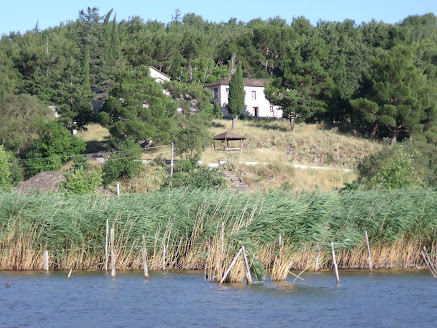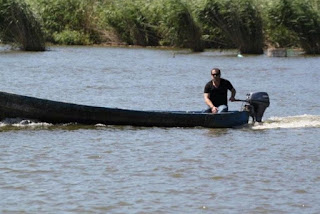Hydrobiology Workshop, Ioannina, Greece, 2012
Location: The Island, Lake Pamvotis, Ioannina, Epirus, Greece
I was fortunate enough to participate in an Erasmus Intensive Programme in Greece in 2012. The workshop I led was to use data-logging equipment and measuring Physico-chemical parameters of the Island in Lake Pamvotis, Ioannina, Greece.
Location of Ioannina
The orientation of the lake, island, and town of Ioannina
Lake Pamvotis is a land-locked freshwater lake in the mountains of Epirus in north-west Greece. Within the lake, is one inhabited island which was in human history an important religious site with seven monasteries dating from the late-Byzantine period, some with exceptional wall paintings. The island has a single settlement at its southern end, and a low hill forms the bulk of the island, with a track/trail circumnavigates the island. A significant stand of reeds lies to the east of the island: the reeds are termed "mat" locally and have a number of traditional uses.
In order to get a comprehensive survey of the lake without using boats to transport to various stations, the cohort of 40 students was divided into 7 groups and measurements were taken at 7 stations around the island. This would diminish the effect of urbanisation, although there is a settlement on the island. Although the city of Ioannina has improved its water treatment with a new water treatment plant post-2012, the settlement of the Island is not part of this improved system, and its sewerage still enters the lake untreated (in summer, the number of inhabitants rises from a few dozen to a couple of thousand [anecdotal report]).
View of one of the monasteries from the ferry looking across through the 'mat' reed beds.
One of the local fishermen of the island in a traditional craft.
Once on the Island, the study groups had to disperse to their research stations:
Using dataloggers:
Dissolved oxygen sensors being calibrated prior to use.
Local academics in discussion!
Discussion back on campus: Prof. Plakitsi (Ioannina), Prof. Nicos Valanides (Cyprus),
Asst. Prof. Thomas McCloughlin (Ireland)
Making home-made nets:Group Discussion
Some results of the net sweep in the lake near reeds: Great Diving Beetles; also observed, water snakes

Physico-Chemical Results (means) using Vernier datalogging/probes:
The location of the sample stations, 1 to 7
The first thing we notice, from a north European standpoint, is how high the water temperature is.
Therefore, there would be a high degree of evaporation fo the water from the lake. Generally speaking, the dissolved oxygen of the lake was low, and yet, maintaining a neutral to slightly alkaline pH level.
Site 3, 4 and 6 displayed soluble ortho-phosphate levels greater than 0.2 mg/L based on absorbance, however all samples displayed high levels of phosphate
Recognizing learning achievements - The Irish Team
Evaluation of the use of dataloggers:
Reference:






















Comments
Post a Comment